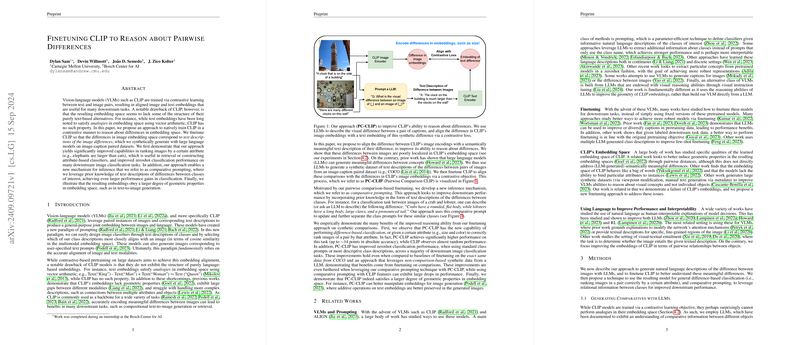Finetuning CLIP to Reason about Pairwise Differences: An Overview
The paper "Finetuning CLIP to Reason about Pairwise Differences" presents a methodological enhancement to contrastive vision-LLMs, particularly CLIP, by enabling it to reason about differences between image embeddings. This is especially pertinent given the limitations in CLIP's native abilities to capture geometric properties akin to their pure text-based counterparts. The authors introduce an approach that employs LLMs to synthetically generate text descriptions of differences between images, which are subsequently used to finetune CLIP for improved reasoning and classification tasks. This essay explores the core contributions, results, and the broader implications of this approach.
Background and Problem Statement
Vision-LLMs like CLIP have shown to be potent in aligning images and text into a unified embedding space using contrastive learning. However, they inherently lack structural proprieties found in purely text-based models, such as analogical reasoning through vector arithmetic. The inability to manipulate and interpret differences in embedding space limits CLIP's functionality in applications requiring nuanced understanding of attributes or comparative descriptors.
Methodology
The authors propose a finely tuned version of CLIP that incorporates reasoning about pairwise differences using LLM-generated comparisons. This approach consists of:
- Dataset Preparation: A synthetic dataset of text describing differences between image pairs is generated leveraging LLMs. For example, differences such as "an elephant is larger than a cat" are illustrated through this synthetic process.
- Fine-Tuning Strategy: CLIP is fine-tuned using a contrastive loss where the model learns to align differences in image embeddings with semantically meaningful text differences.
- Comparative Prompting: A novel inference mechanism refers to comparative prompting, where prior knowledge of differences between classes is used to improve classification performance.
Results and Analysis
The robust empirical results provide multifaceted insights into the efficacy of the approach:
- Difference-Based Classification: Through tasks that involve ranking images based on specific attributes (e.g., size and color), PC-CLIP significantly outperforms standard CLIP, achieving up to 14 points higher accuracy.
- Zero-shot Classification Improvements: The finetuning process not only retains the original zeroshot classification capabilities but enhances performance when using both standard and descriptive prompts across numerous datasets.
- Enhanced Geometric Properties: The fine-tuned embeddings demonstrate a significant improvement in capturing geometric properties, supporting better image generation through arithmetic operations in textual embedding space.
Implications and Future Work
The implications of this research extend both theoretically and practically. Theoretically, it presents a novel intersection of vision-LLMs and LLMs to induce more meaningful geometric representations. Practically, this enhanced CLIP model can potentially improve detailed image retrieval systems, fine-grained classification tasks, and even text-to-image applications, pushing the boundaries of compositional and comparative reasoning in AI systems.
Future research could explore alternative or complementary datasets for generating comparatives, potentially incorporating multimodal LLMs to mitigate issues of representation loss. Additionally, exploring further applications of such enhanced models in complex domains, like autonomous driving or medical imaging, would be compelling.
Conclusion
The work presented in this paper introduces a meaningful advance in vision-LLMing by enabling CLIP to comprehend and reason about differences between image embeddings through finetuning with synthetically generated linguistic datasets. This not only addresses the architectural limitations of the original CLIP model in reasoning about analogies or differences but also opens a plethora of avenues for its application in AI domains requiring nuanced and granular understanding of visual differences.
